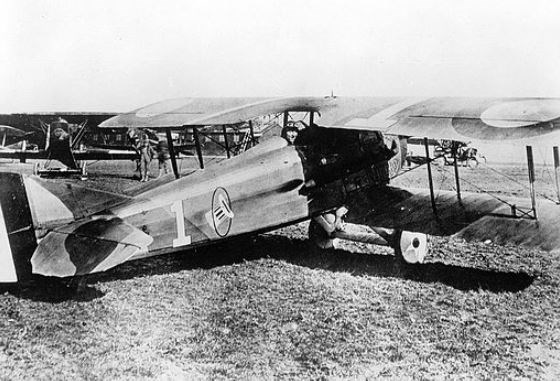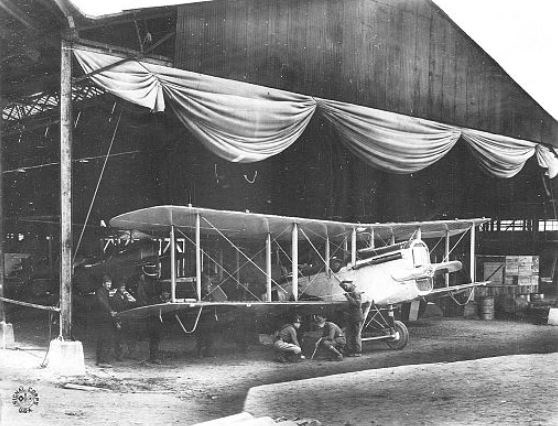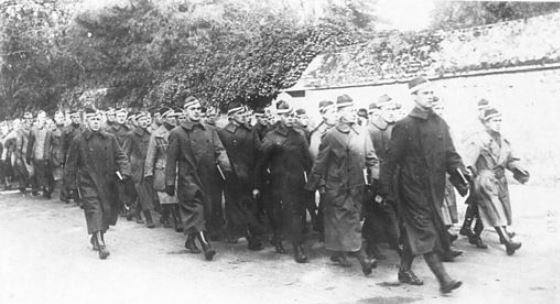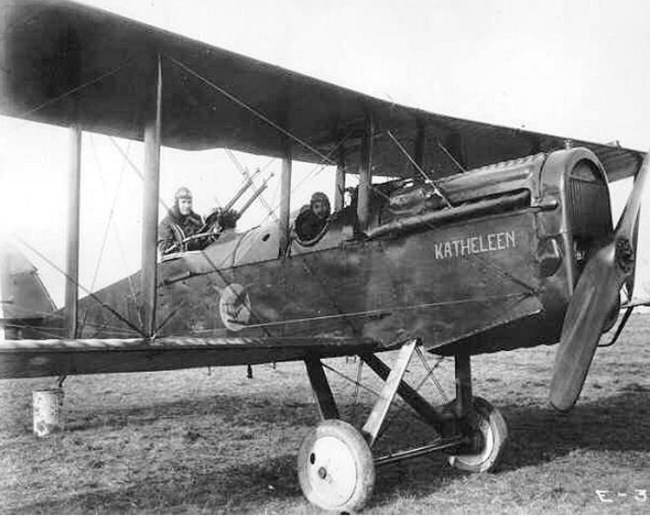Last updated: November 6, 2018
Article
Dayton, Aviation, and the First World War

Air Service, US Army
Significant developments in aviation occurred across Europe and North America during the First World War. Having entered combat nearly three years before the U.S. Congress’s declaration of war in April 1917, researchers and engineers in France and Germany, especially, created important developments that transformed a fledgling industry into an important component of military operations.
Developments in aviation in the United States lagged far behind those in Europe. A battle over patent infringement between Orville Wright (and his brother Wilbur, before his death in 1912) and Glenn Curtiss, especially, held back technological development in the United States, as did a limited market for airplanes. Often costing between $5,000 and $10,000 apiece (between roughly $87,000 and $173,000 in 2015 dollars) and requiring extensive space for takeoffs and landings, only the rich and governments could afford to purchase a piece of an invention just over a decade old. Government – and specifically military – support was vital to the development of aviation throughout the world, and the course of the First World War in Europe demonstrated this. Though they began 1914 with small air forces poorly integrated with existing branches of the military, France, Germany, and the United Kingdom were among the countries where air corps grew rapidly after Austro-Hungarian Archduke Franz Ferdinand’s assassination in Sarajevo. As the war developed, European militaries called for increasingly specialized airplanes that could scout enemy positions, pursue enemy fighters, and bomb enemy positions, types of airplanes that did not exist before the war.

Air Service, U.S. Army
When the war began in Europe, the United States military had very few airplanes – only six airplanes, and fourteen trained pilots, were available for use. Conversely, France’s military had 260 airplanes and 171 pilots, Germany 46 airplanes and 52 pilots, and the U.K. 29 airplanes and 88 pilots. Congressional appropriations for aviation were also much lower than government appropriations in other countries. While the French parliament provided the equivalent of $7,400,000 in 1913, and the German Reichstag $5,000,000, the U.S. Congress provided a mere $125,000, less even than the $400,000 that Mexico devoted to aviation.1 While the administration of President Woodrow Wilson tried to maintain strict neutrality as Europe fought, as the war moved into 1915 and 1916 and as pilots demonstrated that aviation was an important component of modern military tactics, it realized that it needed to strengthen, and strengthen quickly, the position of military aviation in the United States.
When the United States entered the war in April of 1917, the Aviation Section of the U.S. Army’s Signal Corps paled in size and in equipment to its allies and enemies in Europe. It had about 200 airplanes, which a contemporary described as mostly training aircraft that were “nearly all obsolescent,” and very few pilots or mechanics.2 Meanwhile, French forces lost nearly 300 airplanes to combat and accidents in April 1917 alone.3 With U.S. entry into the war, the French government, realizing that its new ally could provide a significant boost to the war-wearied Allied air corps, proposed that the United States expand its air force to 4,500 airplanes by 1918 and be able to replace or reinforce that corps at a rate of 2,000 airplanes per month.4 The French proposal became the basis for the American military aviation program. The U.S. government quickly ended the ongoing patent battle between the Wright and Curtiss corporate interests, creating a patent pool that licensed existing patents to manufacturers and allocated royalties to patent owners according to a set percentage. It also established the Aircraft Production Board (later the Aircraft Board) to provide advice to the Signal Corps on aviation development and production.

Air Service, U.S. Army
With little debate, Congress quickly passed a law in May 1917 making one of the largest appropriations in U.S. history to that point in time, $640 million, to develop that program. But the American aviation industry of early 1917 was not equipped to supply thousands of airplanes to the U.S. military; it had not adopted mass production, and as a result, many orders went to large companies with roots in the automobile industry. The military spread its orders across these various builders, though even they found production to be challenging.5 The largest U.S. airplane manufacturer of the pre-war period, the Curtiss Aeroplane and Motor Company of Buffalo, New York, received an order to build 2,000 copies of the British Bristol fighter, powered by the U.S.-designed Liberty engine), but the original British design used a smaller, lighter engine than the Liberty that the U.S. preferred, which required that the Bristol be extensively redesigned. And there was little clarity from Washington. In September 1917 the U.S. Army also asked Curtiss to build 3,000 copies of the single-seat French SPAD fighter, quickly cancelled the order, and then ordered 1,000 copies of a British SPAD variant the next April, only seven months before the armistice. No U.S.-built copies of the Bristol or the SPAD ever reached Europe, and all of the fighter planes flown by U.S. pilots in American service were of European – and principally French – design and build.6 Many other Americans flew as part of the British or French air corps, including the famed Lafayette Escadrille, especially before the United States entered the war itself; the German air corps did not generally allow foreigners to serve in its ranks.
In addition to ordering fighter airplanes that never reached the battlefield, the U.S. military also ordered 4,000 copies of an already-obsolete observation airplane, the British DH-4 (which the Royal Flying Corps was replacing with the DH-9), for its arsenal. In Dayton, Ohio, several industrialists with close connections with the military, including Charles Kettering and Edward Deeds (who the Army commissioned as a colonel and put in charge of the Signal Corps’ equipment division, placing him in control of Army production of airplanes, before ousting and investigating him for a potential court martial for corruption), created the Dayton-Wright Airplane Company to receive federal contracts and build these aircraft, making sure that the Wrights’ hometown remained involved in aeronautics. Though he lent his name to the company and appeared on its organizational chart, Orville Wright had no ownership interest in Dayton-Wright and little involvement in the company’s operations. While Dayton-Wright’s engineers successfully adapted the DH-4’s design to fit the Liberty engine, mounting U.S. machine guns and other accessories proved challenging, as synchronizing the firing of the guns with the airplane’s propeller was difficult. Problems such as this delayed the commencement of mass production of the DH-4 and its arrival in Europe. With workspace at a premium in the greater Dayton area, Dayton-Wright used the empty former factory buildings of Wilbur and Orville Wright’s Wright Company of 1909-1916 as one of its plants (though nearby Miamisburg and Moraine hosted larger Dayton-Wright factories).

By one measure, production of the DH-4 succeeded in the United States: it was the only U.S.-built military airplane that actually reached Europe before the end of the war. However, it was slow and outmatched by more modern German (and French) airplanes and had a reputation as a “flaming coffin” since its unprotected fuel tank lay between the seats of the pilot and the observer. A bullet strike of this tank could quickly send the spruce-framed airplane careening to the ground in flames. Great War airplane crews did not typically wear parachutes (which existed at the time), so an airplane disabled by enemy fire was generally a deathtrap. Moreover, while workers at Dayton-Wright and the Fisher Body Company built more than 4,500 DH-4 airplanes, they built most of these craft in the last months of the war, and the airplanes, though they reached Europe before the armistice, were not there in time to be employed in combat.7 Only white men were allowed to volunteer to fight as pilots; no draftees were forced into U.S. cockpits. At the end of the war, the U.S. Army Air Service had 7,726 officers and 70,769 enlisted men in its ranks, 816 of whom were killed and 421 were wounded in action during the war.8
Naval aviation also contributed to the course of the war. The U.S. Navy’s aviation program began the war as ill-prepared as the army’s. In April of 1917, it included 48 pilots, 238 enlisted men, and operated 54 aircraft, none of which were appropriate for combat or patrol.9 Finding and attacking – or directing naval vessels to attack – enemy submarines was the principal mission of U.S. naval aviation during the war. During the short period of time that the U.S. was a combatant, its naval aviators flew nearly 22,000 flights and conducted thirty attacks on German submarines. At the end of the war, the Navy and Marine Corps counted 6,998 officers and 32,873 enlisted men in their aviation ranks, though this number quickly fell in the weeks after the armistice. One historian called the Curtiss-designed airplanes built by workers at the Naval Aircraft Factory in Philadelphia “the United States’s true aircraft production success story”; these seaplanes were as technically sophisticated and up-to-date as seaplanes built on the Continent.10
While not the force that it became in later twentieth century wars, aviation was not without consequence in Europe during the First World War. Aerial observation and artillery spotting became common uses for airplanes; commanders incorporated information acquired by pilots and observers into battle plans. Airplanes – more than 1,400 flown by the Allied air corps – proved particularly significant in providing cover during the Allied victory at Saint-Mihiel in France in September of 1918. Aviators also demonstrated that countries such as Great Britain that had previously considered themselves isolated and difficult to attack due to geography could, in fact, easily be attacked from the air. There was a loss of innocence amongst civilian populations as people realized the devastating potential of an air attack on a city far from a war’s front lines, and air forces used strategic bombing extensively and controversially during later wars. The various ways in which militaries used airplanes during the war also caused many governments to begin the process of making their air forces more independent of traditional armies, a process that ended in the United States only with the establishment of the United States Air Force as an independent armed service in 1947. The First World War was one of the earliest wars to incorporate powered flight, but it was not the last.
National Parks and the Great War
World War INotes
1I.B. Holley, Jr., Ideas and Weapons (1953; Washington, D.C.: Government Printing Office, 1997), 29.
2Ibid., 37.
3John H. Morrow, Jr., The Great War in the Air: Military Aviation from 1909 to 1921 (Washington, D.C.: Smithsonian Institution Press, 1993), 199.
4Holley, 41.
5Linda R. Robertson, The Dream of Civilized Warfare: World War I Flying Aces and the American Imagination (Minneapolis: University of Minnesota Press, 2003), 15-19.
6Holley, 125-126.
7Theodore M. Knappen, Wings of War: An Account of the Important Contributions of the United States to Aircraft Engineering, Development, and Production During the World War (New York: G.P. Putnam’s Sons, 1920), 151.
8Mauer Mauer, The U.S. Air Service in World War I, vol. 1 (Washington, D.C.: Office of Air Force History, 1978), 25.
9Adrian O. van Weyn, Naval Aviation in World War I (Washington, D.C.: Chief of Naval Operations, 1969), 6.
10Van Weyn, 89-90; Morrow, 343.
